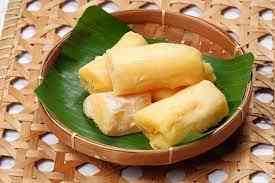Indonesia is famous for its abundance of agricultural products such as spices and cassava. Indonesia is also famous for its many special foods in each region, which are called traditional foods. Some traditional foods are processed in various ways, including fermentation. Cassava tape is a fermented food made from cassava that is popular in Indonesia. Cassava is a plant that is widely cultivated in Indonesia and is used as a source of carbohydrates and energy. Tape is produced through a fermentation process involving microorganisms like yeast, fungi, and bacteria. The starter culture used has a round, flat shape. Locals use terms like "ragi tape" or "yeast tape" to refer to it. Fermentation produces alcohols like ethanol from the cassava starch, giving tape its slightly alcoholic taste. The quality of tape depends on the raw cassava, production method, and microbes involved.
Fermentation is a metabolic process used to preserve foods such as tape. These are microbial enzymes that chemically transform organic substrates. As it is a traditional Indonesian food, there is no set standard for how to make tape and it may vary. Starter cultures contain a mixture of rice flour, spices, water, or sugarcane extract. Yeast plays an important role in anaerobically fermenting sugars into CO and ethanol. As primary microorganisms, they determine sensory properties. This action also makes the texture of cassava soft. Saccharomyces cerevisiae can function in the presence or absence of oxygen and can oxidize sugars and ferment.
Fungi and bacteria also contribute. The fungal amylase enzyme first breaks down starch into glucose. Saccharomyces yeast then converts the sugar into ethanol. Other microorganisms such as Aspergillus, Candida, and Lactobacillus further modify their metabolites. This creates a tape with distinctive fruit, floral esters and acids. There are four main stages in the biochemical changes:
1. Enzymatic hydrolysis of starch into dextrin and monosaccharides.
2. Conversion of sugar into ethanol through fermentation.
3. Oxidation of ethanol into organic acids by lactic acid bacteria.
4. Formation of esters through the reaction of organic acids with alcohol.
Optimizing the fermentation duration affects the final moisture, sugar, and sensory properties. Controlling the temperature can also impact the rate, time, and product outcome. Proper tools, containers, and sanitization of equipment and workers helps ensure food safety and quality.

Many fermented foods that provide health benefits, such as stimulating gut immunity and improving the balance of microbial populations in the gastrointestinal tract. One of the most well-known fermented foods from Indonesia is "tape." Tape is made from steamed cassava, which is then mixed with a starter commonly referred to as "tape yeast". Tape is produced using traditional methods which have some drawbacks, such as non-standardized manufacturing processes and variability in the products. This could result from in consistencies in the microbial composition of the starter, as well as the influence of environmental factors.
The quality of tape depends on the quality of the cassava, preparation method, and microbes involved. The tape starter comprises a consortium of microbes including fungi, yeast, and bacteria. These microbes determine the quality of the tape due to their roles during the fermentation process. Bacillus species have been reported to play a role in improving the quality of various fermented. Bacillus subtilis has also been reported to determine the quality of cassava tape. However, there is very limited information on the diversity of Bacillus strains present in conventionally prepared tape.







